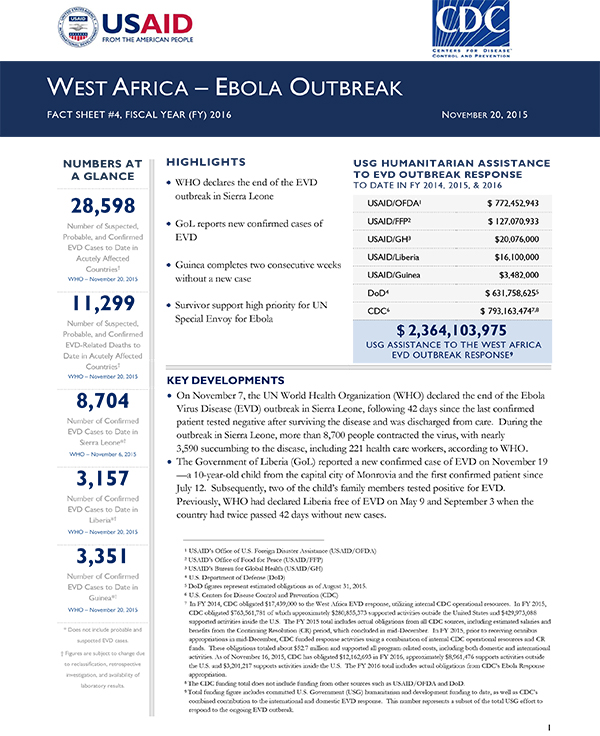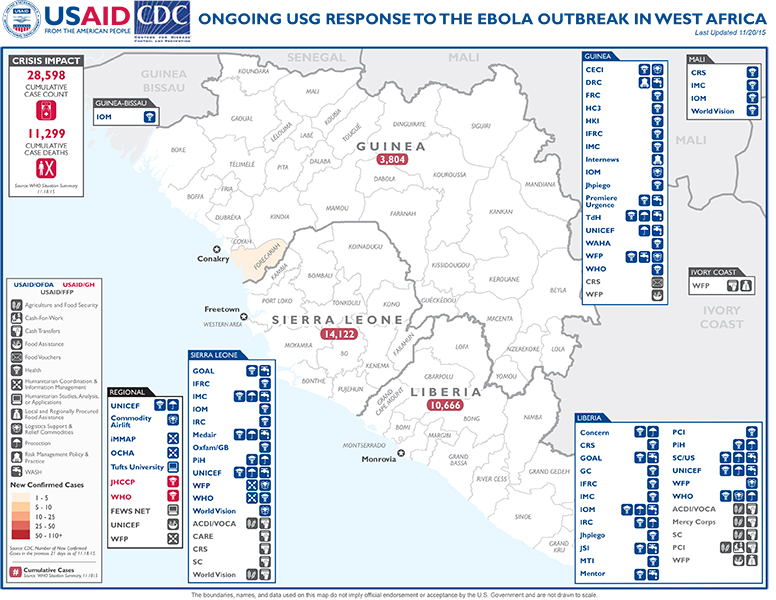Speeches Shim
November 20, 2015
HIGHLIGHTS
Ebola Response
Visit our main West Africa Ebola Outbreak page to learn more about how we're responding to the West Africa Ebola outbreak, and what you can do to help.
- WHO declares the end of the EVD outbreak in Sierra Leone
- GoL reports new confirmed cases of EVD
- Guinea completes two consecutive weeks without a new case
- Survivor support high priority for UN Special Envoy for Ebola
KEY DEVELOPMENTS
- On November 7, the UN World Health Organization (WHO) declared the end of the Ebola Virus Disease (EVD) outbreak in Sierra Leone, following 42 days since the last confirmed patient tested negative after surviving the disease and was discharged from care. During the outbreak in Sierra Leone, more than 8,700 people contracted the virus, with nearly 3,590 succumbing to the disease, including 221 health care workers, according to WHO.
- The Government of Liberia (GoL) reported a new confirmed case of EVD on November 19 —a 10-year-old child from the capital city of Monrovia and the first confirmed patient since July 12. Subsequently, two of the child’s family members tested positive for EVD. Previously, WHO had declared Liberia free of EVD on May 9 and September 3 when the country had twice passed 42 days without new cases.
Regional
On November 18, UN Special Envoy for Ebola Dr. David Nabarro cautioned that while recent progress in the regional EVD response was encouraging, the response was not complete. Dr. Nabarro underscored the importance of Sierra Leone’s 90-day period of heightened surveillance following the formal end of the outbreak in the country. He noted that a current high priority is survivors’ needs, especially social stigma and residual medical issues that survivors confront. The Special Envoy emphasized the need for a comprehensive response package supporting safe sex practices while offering survivors medical care.
Liberia
The GoL confirmed a new case of EVD on November 19—the first case in the country since July. The GoL Minister of Health reported that the patient is a 10-year-old child from the Paynesville neighborhood of Monrovia. On November 20, authorities announced that two members of the child’s immediate family had also tested positive for the virus. The EVD-positive patients are currently receiving care at a GoL-managed EVD treatment unit (ETU) in Monrovia—staff from CDC and WHO are working with Liberian health staff to ensure the ETU is prepared to manage cases. Health responders have identified and isolated high-risk contacts, including the patient’s other family members. The GoL has activated the national-level incident management system, and tracers are identifying contacts to begin monitoring for symptoms, according to USG staff in Liberia.
On November 6, representatives from the USG Disaster Assistance Response Team (DART) attended a decommissioning ceremony of the USAID/OFDA-supported ETU in Sinje town, Grand Cape Mount County. Managed by the International Organization for Migration (IOM), the Sinje ETU was operational from December 29, 2014, to September 30, 2015, and treated 31 patients. Additionally, with USAID/OFDA support, IOM operated an adjunct mobile clinic, which screened approximately 6,500 individuals for possible EVD symptoms between April and November.
From November 10 to 11, the GoL piloted an epidemic preparedness- and response-planning workshop in Lofa County. Workshop participants—Lofa County Health Team members, the county superintendent, hospital medical directors, and WHO representatives, among others—drafted a plan outlining preparedness efforts and response activities in the event of potential EVD or other infectious disease epidemics. The plan assigned specific responsibilities to District and County Health Team staff and established protocols for communities and health facilities to communicate with district and county health teams. As part of the workshop, participants assessed Lofa’s existing resources and preparedness level, identifying gaps in response capacity. The workshop is part of ongoing GoL efforts to bolster infectious disease preparedness and response capacity at the county and national level. Once each county has completed a workshop, the GoL plans to integrate results into a national epidemic preparedness and response strategy.
West Africa Map - 11-20-2015 ![]() (pdf - 523k)
(pdf - 523k)
Sierra Leone
Despite WHO declaring the formal end of the outbreak on November 7—the first confirmed case was recorded on May 24, 2014—EVD response actors caution that Sierra Leone remains at risk for potential cases given factors such as the endemic animal reservoir, potential sexual transmission among survivors, and ongoing transmission in the region. Accordingly, Sierra Leonean President Ernest Bai Koroma endorsed a WHO recommendation to undertake a 90-day period of heightened surveillance starting November 8. Sierra Leone’s National Ebola Response Center (NERC) has instructed the Surveillance Pillar—the national body responsible for designing, implementing, and monitoring EVD surveillance activities—to draft a list of prioritized activities for the surveillance period.
In parallel to the period of heightened surveillance, the Government of Sierra Leone (GoSL) will continue the transition from an emergency response to post-outbreak recovery. As part of the process, the NERC will stand down on December 31, with GoSL agencies assuming responsibility for strategic direction and coordination of national and public health emergencies.
On November 15, DART members attended a ceremony marking the closure of the USAID/OFDA-supported ETU in Lunsar town, Port Loko District. The ETU ceased operating on November 7. Between December 1, 2014, and November 7, 2015, the Lunsar ETU screened more than 550 individuals and confirmed nearly 100 EVD cases.
Guinea
The Government of Guinea (GoG) last reported a new confirmed case of EVD on October 29—an infant from Forécariah Prefecture. On November 17, the infant tested negative for EVD, making Guinea free of active EVD cases, according to WHO. Since WHO declares the end of an EVD outbreak once a country is free of all cases and subsequently passes 42 consecutive days without a new confirmed case, Guinea began its 42-day period on November 17.
The final 69 remaining contacts of known cases in Guinea—all from the Kaliah sub-district of Forécariah—graduated from a 21-day monitoring period on November 14, marking the first time since the start of the outbreak that Guinea had no contacts under observation.
The GoG has identified survivor assistance—medical care, psychosocial support, economic assistance, and social reintegration—as one of four national priorities for Phase 3 of Guinea’s EVD response. In conjunction with completing a strategic national plan, the GoG—in coordination with the UN Office for the Coordination of Humanitarian Affairs (OCHA) and WHO—is identifying partners engaged in or planning to conduct survivor-related activities. Current programs include follow-up medical care for survivors, provided by the Alliance for International Medical Action (ALIMA). ALIMA is currently providing free health care to more than 100 survivors in Beyla, Lola, Nzérékoré, and Yomou prefectures.
PUBLIC DONATION INFORMATION
- The most effective way people can assist relief efforts is by making cash contributions to humanitarian organizations that are conducting relief operations. A list of humanitarian organizations that are accepting cash donations for disaster responses around the world can be found at www.interaction.org.
- USAID encourages cash donations because they allow aid professionals to procure the exact items needed (often in the affected region); reduce the burden on scarce resources (such as transportation routes, staff time, and warehouse space); can be transferred very quickly and without transportation costs; support the economy of the disaster-stricken region; and ensure culturally, dietary, and environmentally appropriate assistance.
More information can be found at:
- The Center for International Disaster Information: www.cidi.org or +1.202.821.1999.
- Information on relief activities of the humanitarian community can be found at www.reliefweb.int.
USAID/OFDA bulletins appear on the USAID website at what-we-



Comment
Make a general inquiry or suggest an improvement.